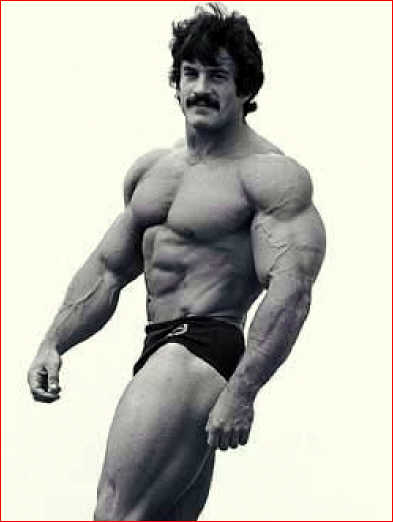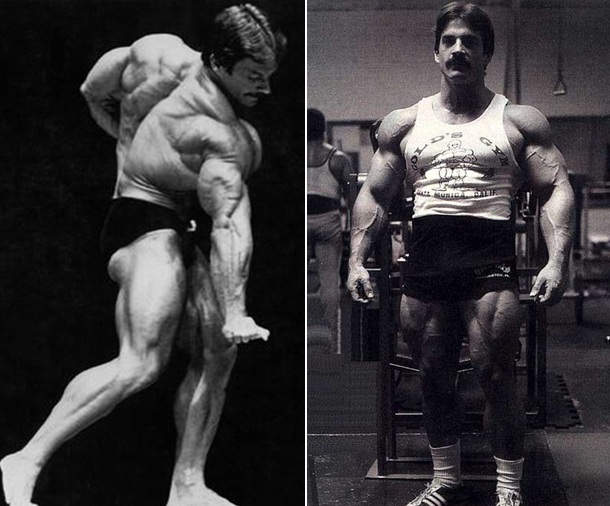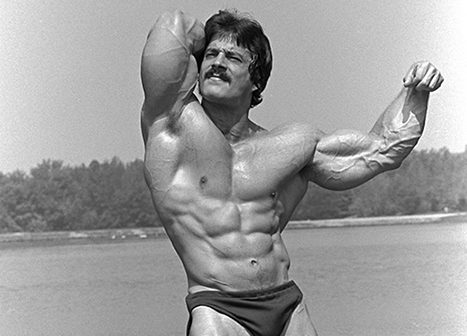Mike Mentzer's Views on Forced Repetition.
Forced and negative repetitions can be very beneficial.
Mike Mentzer had trained more than 2000 clients and had written and archived as many training reports on them.
He was among the first to recognize the following important aspects:
- If you train too intensively, for example with too much workload or too often in the studio, you can quickly overtrain. And from such overtraining, the human body simply cannot recover in seven days.
Forced repetitions are used to train a muscle beyond positive failure. On the one hand, this can be a method of getting the most out of fiber recruitment in a sentence. On the other hand, such a training method can also have negative effects if it is used with every workout.
This has to do with the fact that some fibers, such as FT fibers, require a very long recovery period once they have been recruited. Studies on sprinters, in which the motor units of the FT fibers are almost exclusively activated, had shown that the recovery time of these fibers can take up to three weeks!
MIKE MENTZER THE STORY
 When Mike Mentzer first appeared on the bodybuilding scene in the late 1970s, he was instantly charged like a roaring lion. He easily won the Mr. America in 1976, and shortly afterwards he finished second at the IFBB World Championship in Montreal, just behind legendary Robby Robinson, who was considered almost unbeatable at the time.
When Mike Mentzer first appeared on the bodybuilding scene in the late 1970s, he was instantly charged like a roaring lion. He easily won the Mr. America in 1976, and shortly afterwards he finished second at the IFBB World Championship in Montreal, just behind legendary Robby Robinson, who was considered almost unbeatable at the time.
Even veteran journalists have been forced to describe Mike's rapid rise as "almost supernatural." Rick j Wayne, who had already seen everything 1 in bodybuilding, was impressed: “His training methods indicate a certain strength of will, because he is not afraid to question old training concepts or to expose old myths as false.
Like a scientist, he is discovering new ways to make greater progress in bodybuilding.
Many will think Mike's ideas are completely revolutionary, but they don't have to be. It's just that a lot of bodybuilders are afraid of going to the limit. Mike Mentzer, on the other hand, succeeds in exploring his extreme limits.
One of the techniques Mike used at this stage in his competitive career was forced reps. Most of us have heard of it and maybe even trained with this technique every now and then.
However, Mike had specific reasons for including them in his training. And in a very special way. However, what worked and was productive for Mike must be seen in the context of his overwhelming genetic disposition. Because of his genetics, he was able to train with greater intensity. And yet he was able to recover from his workouts in three to seven days. The average bodybuilder is unlikely to recover easily.
TRAININGSTECHNIK
 If you want to stimulate as many muscle fibers as possible within your physically limited recovery capacity, you can do so with the help of “advanced” heavy-duty techniques.
If you want to stimulate as many muscle fibers as possible within your physically limited recovery capacity, you can do so with the help of “advanced” heavy-duty techniques.
These include forced and negative reps, hyper-reps, the rest-pause method, and static hold. You can train with these techniques depending on your mood. Or just when you “feel” that your body is asking for it.
However, the fact that you are feeling fresh again after four or five days of recovery means only one thing: that the post-workout symptoms from your last exercise have subsided; but not that the recovery process is complete or that overcompensation has started.
So should you be making use of advanced techniques like forced reps? And how exactly do they work?
Let's let Mike tell how he used this technique:
“I think forced reps should only be done towards the end of strictly performed reps. Having a training partner helps me go beyond normal failure. So you can first complete as many tight repetitions as possible and then continue with the help of a training partner who is familiar with your training method. Your partner will help you with the last few repetitions that you would otherwise not be able to do. "
Next, Mike explains how he would normally complete a work set before moving on to forced reps: “I don't like doing more than eight and less than five repetitions. So I train hard enough that I can squeeze out maybe eight reps without moving backwards or cheating. My training partner only helps me with his hands to the extent that I can still make an energetic positive movement. It doesn't make life easier for my partner. It only enables me to complete the exercise. "
You realize that without this little help it would otherwise be impossible to finish the exercise. It is important that your training partner knows exactly what you want to achieve. If not, he could screw it up. I think the help of a good workout partner is better than trying to get similar results through sloppy technique or pushing up the weight with false reps. With the help of the partner, the training can be completed more effectively. It also makes it much safer. When you fake or heave the weight up to finish a rep, it is very difficult to control the contraction. Especially if you are using heavy weights and the ligaments are subjected to jerky movements. The connective tissue is also heavily strained as a result.
Some claim that heavy weights are not necessary to build muscle. They then appeal to bodybuilders like Arnold Schwarzenegger oder Robby Robinsonwho have trained with moderate weights in order to achieve an adequate “pumping effect”.
 Mike saw it a little differently: “When Arnold laid the foundation stone for his career in Europe, he was training with heavy weights. As far as I know, he actually did a lot of powerlifting. He used weights that he personally found heavy for most of the exercises. When he came to America, he still had to refine what he had achieved in Europe. So he stuck to his relatively "lighter" training weights. Robby also trained with forced repetitions and heavy weights. "
Mike saw it a little differently: “When Arnold laid the foundation stone for his career in Europe, he was training with heavy weights. As far as I know, he actually did a lot of powerlifting. He used weights that he personally found heavy for most of the exercises. When he came to America, he still had to refine what he had achieved in Europe. So he stuck to his relatively "lighter" training weights. Robby also trained with forced repetitions and heavy weights. "
Mike Mentzer was often associated with the bodybuilding legend Reg Park who was famous for his strong and dense muscles. Park was one of the first bodybuilders to use very heavy weights in his workouts. He typically did standing calf raises at well over 500 pounds. Mike could understand it when he was compared to Reg.
And he believed he understood the reasons why his body was similar to Reg's: “I would say that the similarity begins with the fact that we inherited a certain bone structure from our parents. Still, I believe that the strong and tight muscles we both have (perhaps the hallmark of our bodies) are the result of both of us training mostly with very heavy weights and forced repetitions. "
SCHWERES TRAINING
When Mike says he used very heavy weights, he really meant it. On the incline bench press, he trained for eight repetitions, typically 140 pounds. And he did flies on the incline bench with 55 kilos of dumbbells.
About the training weights in preparation for the Mr. America, Mike wrote:
- Leg Press - 545 Kilo x 5 Wh
- Schrägbankdrücken – 150 Kilo x 3 Wh
- Squats - 250 pounds x 5 Wh
- Neck press - 135 kilos x 5 Wh
- Bench press - 210 pounds x 5 Wh
- Schrägbankdrücken – 175 Kilo x 5 Wh
- Deadlift - 300 pounds x 5 Wh
With all these weights, he always did multiple repetitions, no single repetitions! Apparently, heavy weights are the hallmark of his training sessions. I remember being Mike at the old one „Gold’s Gym“ in Venice, Kalifornien, beim Training zusah. Er benutzte bei der alten Nautilus-Multistation für die Brust den ganzen Gewichtsstapel der Butterflymaschine. Dann steckte er noch weitere 20 Kilo auf den Stapel, um beim Bankdrücken auf der Negativbank der Maschine ein paar weitere Wiederholungen herauszuquetschen. Außerdem gab es da noch den alten Nautilus-Beinstrecker, der eine wirklich große Platen hat. Daran absolvierte Mike einbeiniges Beinstrecken – mit 100 Kilo für acht Wiederholungen. Und für die Scott Curls benutzte er eine 80 Kilo schweren Langhantel.
HEAVY DUTY FORCED REPS
When higher exertion is no longer possible. However, you can increase the intensity by having your training partner help you do two or three forced reps.
In most cases, it's best to keep the same weight on the bar. Your partner should then only help you just enough so that you can just manage the repetition with all your strength. "
TRAINING WITH REASON
Früher wurde Mike immer gefragt, ob Reduktionssätze genauso ergiebig seien (bei Reduktionssätzen verringert man das Gewicht und absolviert dann noch weitere Wiederholungen). Mikes Antwort war stets nein: „Wenn Sie das Gewicht zu sehr verringern, ist bei der nächsten Wiederholung nicht die größte Kraftanstrengung erforderlich. Sie werden also weniger intensiv trainieren als bei der letzten präzise ausgeführten Wiederholung, die Sie alleine gemacht haben. Wenn Sie jedoch mit demselben Gewicht weitertrainieren und gerade mal genug Hilfe von Ihrem Trainingspartner bekommen, können Sie sicher sein, dass Sie Ihre Intensität steigern werden.“
 FORCED REPS FOR BEGINNERS?
FORCED REPS FOR BEGINNERS?
However, forced reps are not required for beginners. And intermediate beginners shouldn't train with this technique all the time. Unless they pay special attention to their recovery.
MIKE MENTZER'S LAST WORDS ON FORCED REPS
Let Mike have the final say on this important aspect: “Bodybuilders past the beginner stage can do forced repetitions on one of the pre-exhaustion exercises, that is, either the isolation or the compound exercise. You should probably only do this every other training session.
Advanced strength athletes who train on a shortened program between every seventh and tenth day can use this technique for almost every workout. However, you need to monitor their training successes to ensure that they are recovering adequately and making progress. If this is not the case, you need to use this technique more sparingly.
Mike continues on advanced: “Advanced bodybuilders who require higher intensity and who are more familiar with how their body reacts to training need to improvise with this technique and make it dependent on their training progress. You can deviate from the recommended rep plan, which includes between six and ten repetitions followed by forced repetitions. The larger and stronger muscles put a lot more strain on their cardiovascular system and other body systems when they contract heavily. You should therefore use weights that allow you to do a maximum of four strictly positive repetitions. But that's a question of self-assessment. "

already read..?
ARNOLDS PSYCHOTRICK BEI MR. OLYMPIA 1980


4 comments
Comments are closed.